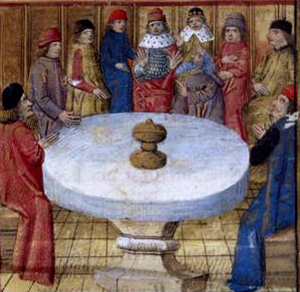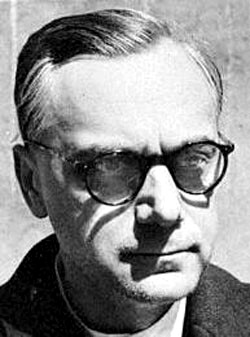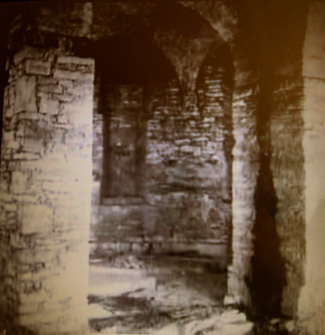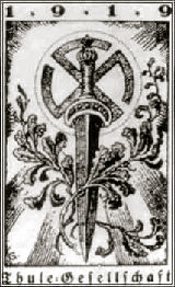 |
Secret Forces
Nazism, a Gnostic-Manichean Sect - Part III
What the Grail Represented for the Nazis
Cunha Alvarenga
According to a medieval legend, the Holy Grail or Sangrail would be the chalice chiseled from a magnificent emerald on Lucifer’s diadem. When the archangel rebelled against God and fell into Hell, that precious stone would have fallen to earth, where it was made into a chalice.

The legend says the Grail was guarded by the Knights of the Round Table |
Still according to the legend, this 144-facet emerald chalice would have been used by Our Lord at the Last Supper. Afterward, Joseph of Arimathea would have used it to collect the Precious Blood of Christ that flowed from the wound made by Longinus’ spear. This sacred vessel, laden with extraordinary virtues, would have mysteriously disappeared, after having been in the possession of the Knights of the Round Table.
According to author Jean Michel Angebert of Hitler and the Cathar Tradition, the first Gnostic significance of the Grail was appropriated and changed by Christianity. He notes:
“For the adherents to the great tradition of unity, that is, the fundamental and transcendent unity of all religions, legends and various mythologies, it is obvious that the Christians appropriated the Grail myth, making it the emerald goblet containing the Blood of Christ, and thus straying from its first meaning.”
“The loss of the Grail was associated with the loss of the tradition of unity, with all its spiritual consequences,” he continues. Therefore, “the original myth of the Grail is related to a lost teaching. This was the interpretation adopted by the National-Socialists, who thought that the Grail-stone was a law of life valid only for certain [pure] races” (pp. 32-33).
The goal of Otto Rahn’s mission in Southern France – above all his research in the ruins of the Castle of Montségur – was to find the Grail-stone containing the secret of the origin of the world. The Grail would be the sacred teaching about the Aryan race that had been lost, then found, and finally hidden by the Cathars in the fortress of Montsegur. Angebert says:
“This was the reason why Otto Rahn, a great specialist in Catharism, was sent to the Albigensian region by the pontiffs of Nazism, to find the famous Grail-stone praised in the poems of Wolfram d’Eschenbach [see Parzival], who speaks of a ‘precious stone.’ Now then, the Manicheans originated in Persia, and by race were Aryans. They linked their word Gorr (precious stone) to the word Al (shine), and came up with Graal [or in English, Grail], meaning an engraved precious stone. This would be the etymological origin and historical foundation of the Grail. This would be the reason for the interest of the Nazi leaders, led by Rosenberg, in those researches” (p. 34).

Alfred Rosenberg, the esoteric intellectual of Nazism |
In his famous book The Myth of the Twentieth Century, Alfred Rosenberg explains the titular myth: “Today a new faith awakes, it is the myth of the blood, which under the sign of the swastika unchains the racial world-revolution. It is the awakening of the race soul, which after a long sleep, victoriously ends the race chaos” (apud Hitler et la Tradition Cathare, p. 34).
Adolph Hitler gave this enthusiastic appraisal of the book, which in itself says a lot: “When you will read the new book by Rosenberg, you will understand these things because it is the strongest work of its kind, even greater than the one by H.S. Chamberlain [the two-volume book The Foundations of the 19th Century published in 1899]” (Otto Strasser, Hitler et Moi, Paris, 1940, apud Hitler et la Tradition Cathare, p. 35). H.S. Chamberlain and the Count of Gobineau can be considered the precursors of Nazi racism.
Another noteworthy Nazi philosopher was Rosenberg’s biographer and contemporary Alfred Baumler. Regarding the Grail myth, Baumler wrote: “The myth of blood is not just one mythology among others, not just one religion among the many old religions. Its content is the mysterious backdrop of the myth itself. From its structure, all myths came. It is not another mythology, but it is the myth itself, even as it is life contemplated with veneration. The development of its occult reality is the axle of our time.” This development, according to him, took place in Germany with Nazism, which incorporated “everything that is great and that belongs to us in the past, everything that has contemporary power and everything expectant in the future.”
Commenting on this text, author Angebert adds: “Enlightened by these explanations we can delve deeper into the neo-Gnosticism, or rather the Manichaeism, of the Nazi leaders and intellectuals, which is based on a racist Gnosis. Their great concern was to adapt all myths to the 20th century” (p. 35).
A movement led by wizards and warlocks

Above, what was left of the crypt in Wewelsburg Castle after Himmler ordered its destruction in April 1945 |
The Gnostic Otto Rahn enjoyed great prestige among the Nazi leaders and is credited to have founded a neo-Catharist circle within the SS. Another of his books, Lucifer's Court in Europe, was made by Himmler obligatory reading for all Nazi dignitaries, “conferring on it the role of a gospel” (p. 64).
That same Heinrich Himmler, very interested in Rahn’s research at Montsegur, renovated and re-designed the Castle of Wewelsburg near Paderborn in Westphalia. Since 1934 it was used by the SS under Himmler and was to be expanded to the central SS-cult-site.
Under a large meeting hall of that castle, he built the “holy of holies,” so to speak, a crypt made of arches having at its center a black marble altar marked with the large letters S.S. in silver, designed in the runic alphabet.
Himmler and SS officers chosen by him would gather in this large hall for special meetings and to perform occult rituals. Angebert explains:
“The meditations of the guests of Wewelsburg were on biological mysticism, the morals of honor, the spiritual myth of blood, and other Gnostic and dualistic subjects dear to the elites beyond the Rhine. These retreats were made in the large room of around 500 square meters, above the crypt where the altar of the new religion was constructed” (p. 65).
As we can see, Nazism was not just a political phenomenon, but a movement led by wizards and warlocks in a country highly advanced in science and technology. This confirms the rule set out by Goethe in Faust, whereby the extreme of scientific rationalism leads to the practice of the occult and magic.

Symbol of the Thule Society, precursor of the Nazi party |
In this regard, Angebert clearly states the aim of his book: “We offer to the reader an analysis of National Socialist thought through the labyrinth of esoteric traditions. Its central theme is Gnosis in its more representative expression, Manicheism, and then its natural development to Catharism, which was characteristically a medieval neo-Gnosticism. It goes on to study the Templar Knights. Thenceforth Gnosis hides itself, reappearing with the Rosicrucians and the Enlightened of Bavaria; after many twists it surges again in the mysterious Thule Society [an occultist group in Germany centered on the Grail and origins of the Aryan race, later transformed by Hitler into the Nazi Party] ” (p. 72).
The Third Reich in Germany was not just the continuation of the First Reich under Bismarck and the Second Reich under William II, as some pseudo-historians pretend. To the founders of the Third Reich, the Germany of Adolph Hitler appeared as a supposed third era of mankind (p. 193). The Führer himself declared: “There were the ancient times of the distant past. Now we have our movement. Between the two there was the middle age of mankind which lasted until us. We will finish it” (Herman Rauschning, Hither m’a dit, Paris, 1939, apud Hitler et la Tradition Cathare, p. 193).
According to certain authors, Rudolf Hess would have led Hitler into occult practices. Jean Michel Angebert thinks differently. He thinks that the Nazi leader had already entered into such practices either by his pseudo-mystical formation or through his initiation in the Thule Society.
Continued

Posted April 9, 2008
Translated from Catolicismo, September 1971
History | Home | Books
| CDs | Search
| Contact Us | Donate

© 2002-
Tradition in Action, Inc. All Rights Reserved
|
 |

|
|